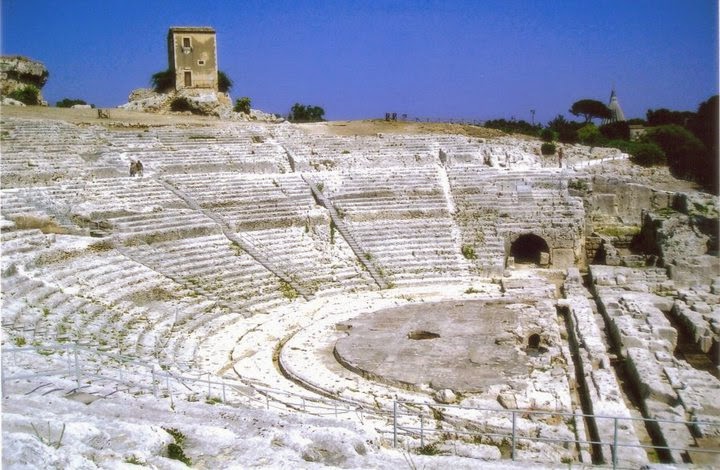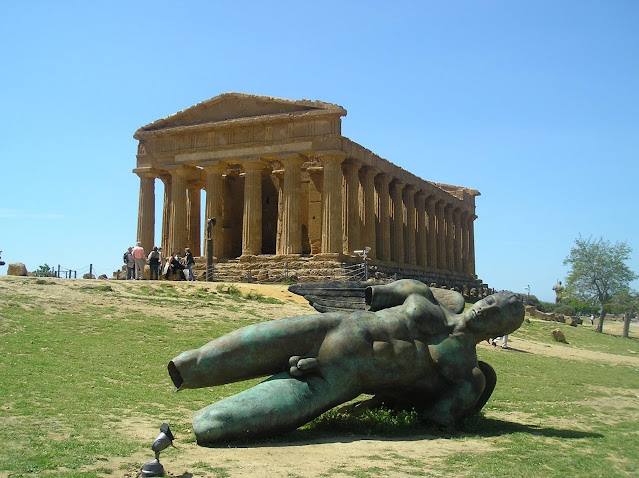Syracuse ... The Archaeological Park
 |
| Teatro Greco (Greek Theatre) |
Syracuse was founded in 733BC by Corinthian settlers from
Greece.
Syracuse became one of the first Greek colonies in Sicily, Giardini Naxos being the first. It quickly gained wealth and power and through warfare became the strongest city in the Mediterranean and the ancient world.
Syracuse became one of the first Greek colonies in Sicily, Giardini Naxos being the first. It quickly gained wealth and power and through warfare became the strongest city in the Mediterranean and the ancient world.
The ancient city was up to three times the size of modern
Syracuse today and was divided into five zones, Epipolae, Akradina, Tyche, the
island of Ortigia and Neapolis, where the archaeological park is located.
After the death of the ruler Hieron II, Syracuse sided with
Carthage against the Romans. After a siege lasting two years Syracuse finally fell
to the Roman Empire in 211BC and was burned down by the Arabs in AD878.
Syracuse never regained the importance it had held for centuries.
 |
| Roman Amphitheatre |
On arrival to the park the first sight you will see is the
Roman Amphitheatre, the arena was built in 3rd Century BC and is one
of the largest of its kind.
Here, traditional circus games were shown, with gladiators and wild animals providing spectacles of blood curdling violence. In the centre is a rectangular hole that is thought to have been used as a drainage system for the blood and gore.
Here, traditional circus games were shown, with gladiators and wild animals providing spectacles of blood curdling violence. In the centre is a rectangular hole that is thought to have been used as a drainage system for the blood and gore.
Walking towards the Teatro
Greco (Greek Theatre) on Via Paradiso
you pass by the Altar of Hieron II. Built in 225BC this enormous altar was
the largest in Magna Graecia (Greater
Greece) and was dedicated to the god Zeus. Today only the base remains, it was
used for sacrifices and it is said that up to 450 bulls would be led up to the
altar to be sacrificed in annual feasts.
 |
| Teatro Greco (Greek Theatre) |
Next you will find the spectacular Greek Theatre, built in 6th Century BC it became the largest theatre in Sicily, it would have had 59 rows and sat a capacity of up to 15,000 people. The Romans carried out alterations to adapt the theatre for gladiatorial combat.
Despite having a reputation as war lords, Syracuse’s rulers were patrons of the arts.
The Greek tragedies of Aeschylus, Euripides and Sophocles are some of the masterpieces of ancient history that come alive today in the natural setting which allows extraordinary acoustics. Performances are usually held from May until the end of June.
Located above the theatre is the Nymphaeum and Street of
Tombs. The Nymphaeum is a grotto which was fed with water from an ancient
aqueduct. The Via dei Sepolcri (Street
of Tombs) is an ancient road filled with niches and Byzantine graves.
Walking back on Via
Paradiso head for the Latomia del
Paradiso, this is a quarry where the stone was used entirely for the
construction of Syracuse. It is now more of a garden planted with citrus,
oleander and bay trees. Within the quarry is the legendary Orecchio di Dioniso
(Ear of Dionysius) a cavern which got its name from the large opening
resembling a pointed ear. This is a natural cave carved into the rock, 23
metres high.
 |
| Ear of Dionysius |
According to legend it was once a prison at the time of the
tyrant Dionysius. Thanks to the remarkable acoustics of the cave, words
whispered in one part can clearly be heard elsewhere. As a result the
prisoner’s conversations were discovered because they were unaware that they
could be heard. You must try it ...
The painter Caravaggio gave the cave its name on noticing the resemblance to an human ear.
The painter Caravaggio gave the cave its name on noticing the resemblance to an human ear.
The quarry is also supposedly the location of the tomb of
the renowned mathematician Archimedes who was born in Syracuse in 287BC and
died in 212BC.
We would recommend a morning visit before visiting the
Island of Ortigia before the temperature rises and the Sicilian sun sizzles in
the park.
If you are a lover of archaeological finds the Museo Archeologico (Archaeological Museum) is a stones throw
away from the park and holds artefacts that have been found during digs in
Syracuse and surrounding areas, including fragments from the two Doric temples
on Ortiga, Athena and Apollo.
 |
| Pantalica Necropolis |
Nearby Pantalica Necropolis was Sicily's largest necropolis with more than 8000 tombs, you can take a hike through the gorge past thousands of ancient burial sites carved into the cliffs.
Castello di Eurialo is a Greek military castle built in 402BC and at Cave d'Ispica, a hollow gorge, the cliff sides are hollowed out to form ancient Byzantine tombs and cells.
Syracuse is approximately a one hour and twenty minute drive from Taormina, why not book a private English speaking driver to accompany you with local inside knowledge, ensuring you see all the wonderful sights and experience of the magic of Syracuse.
If you loved this why not read my last post; Syracuse ... The Island of Ortigia
 |
| Altar of Hieron II |
 |
| Nymphaeum |
 |
| Summer Greek Drama's Thank you for following me at White Almond Sicily I am also a contributor to www.timesofsicily.com For NEW Blog updates and all things Sicilian Click and Like my Facebook page www.facebook.com/whitealmondprivatesicily/ You can also follow me on Twitter, Instagram, Pinterest, Google + and LinkedIn for Travel Tips and Recommendations Email me at: sarah@whitealmond-privatesicily.com Love Sarah x |



